These Bauhaus Art Students in 1927 Look Like Postpunk Bauhaus Fans
What is Bauhaus exactly? Bauhaus art is associated with a specific establishment. The Bauhaus was undoubtedly the most significant progressive schoolhouse of art in the 20th century and was responsible for the development of many prominent Bauhaus artists. Even after it closed under extreme force per unit area from the Nazi authorities in 1933, the Bauhaus design schoolhouse's attitude to education and the link between lodge, art, and applied science had a huge result in the United States and Europe.
Table of Contents
- one The History of Bauhaus Art
- one.1 The Early Days of the Bauhaus Motion
- 1.2 Bauhaus Styles and Concepts
- 1.3 The Faculty of the Bauhaus
- ane.iv The Bauhaus Motion in Dessau
- 1.5 Subsequently the Close of the Bauhaus Blueprint School
- 1.6 Central Ideas of Bauhaus Design
- 2 Of import Bauhaus Artists and Artworks
- ii.1 Red Balloon (1922) by Paul Klee
- 2.2 Yellow-Red-Blue (1925) by Wassily Kandinsky
- 2.3 Gild Chair (1925) past Marcel Breuer
- 2.4 Universal Bayer (1925) by Herbert Bayer
- 2.5 Photogram (1926) by László Moholy-Nagy
- 3 Frequently Asked Questions
- 3.1 What Is Bauhaus?
- 3.two What Defines the Bauhaus Style?
The History of Bauhaus Art
The Bauhaus style was inspired past 19th and early on 20th-century creative tendencies including the Fine art Nouveau style and the diverse foreign versions like the Vienna Secession and Jugendstil, besides as the Arts and Crafts move. All of these groups desired to blur the line betwixt the applied and fine arts, as well as to reconnect imagination and fabrication; their heritage was represented in the romantic medievalism of the Bauhaus movement'due south ideology during its formative days when it styled itself equally some kind of craftsmen's wedlock.
By the mid-1920s, however, this ideal had given identify to a focus on integrating industrial Bauhaus graphic design and art, and information technology was this focus that anchored the Bauhaus' virtually innovative and significant achievements.
The institution is also known for its outstanding teachers, who accept since spearheaded the development of contemporary art – and modern ideas – throughout the United states and Europe.
The Early Days of the Bauhaus Movement
The Bauhaus, titled later on a German phrase that means "business firm of construction," was created in 1919 past architect Walter Gropius in Weimar, Deutschland. He took over a pre-existing school of Craft in 1915, and the revolutionary new Bauhaus fine art school was founded iv years later on via the merging of this institution with the Weimar Academy of Art.
The Bauhaus fashion sprang conceptually from late 19th century impulses to combine fine and applied fine art, resist the industrialization of creativity, and better education.
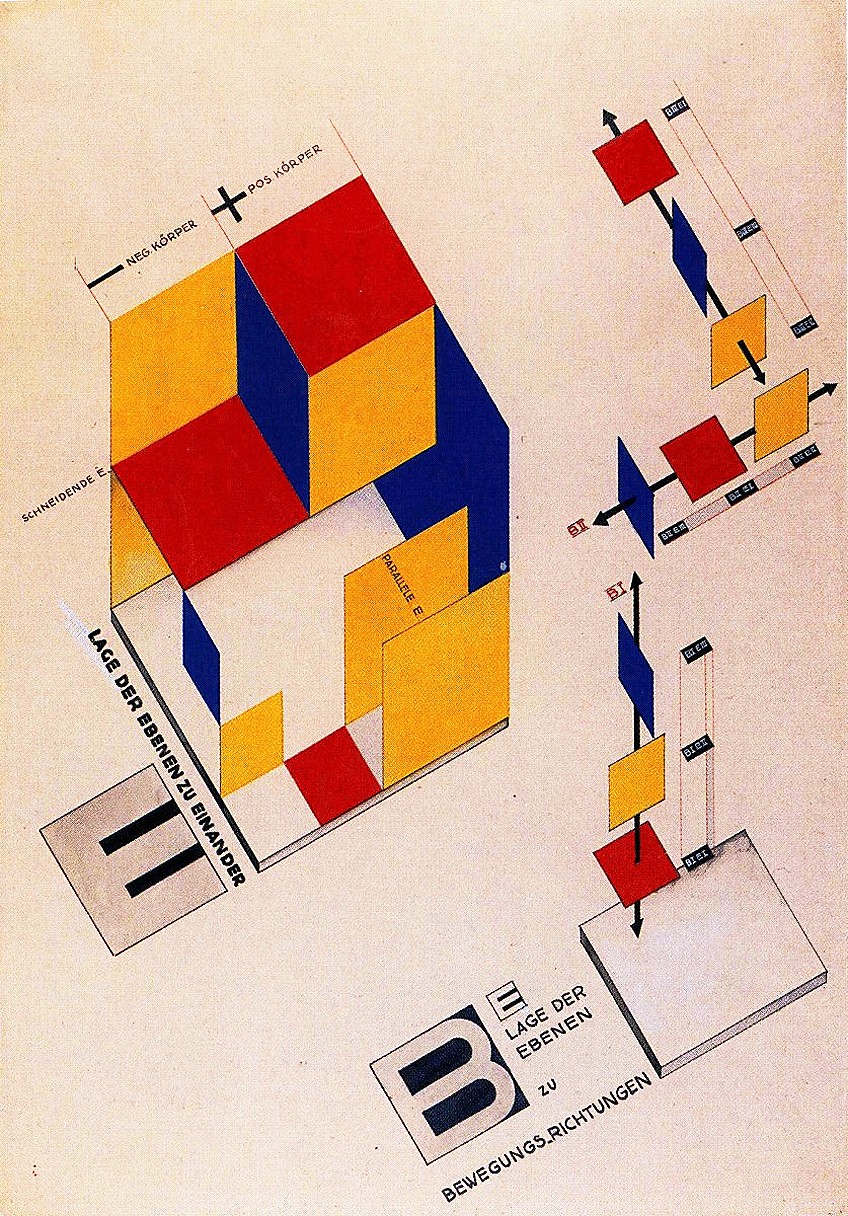 Mechanical stage design (1925) by Joost Schmidt, ink and tempera on paper;Joost Schmidt , Public domain, via Wikimedia Eatables
Mechanical stage design (1925) by Joost Schmidt, ink and tempera on paper;Joost Schmidt , Public domain, via Wikimedia Eatables
Simultaneously, the 1910s ascent of Russian Constructivism provided a more urgent and aesthetically appropriate predecessor for the Bauhaus' fusion of artistic and mechanical design. When the Bauhaus officially opened in 1920, it took up abode in the one-time sculpture workshop of the 1000-Ducal Saxon institute, synthetic in the Art Nouveau manner.
Gropius urged the school to develop a fresh appreciation for adroitness and functional ability, implying a reversion to medieval ideals toward arts and crafts. He saw the Bauhaus motility equally roofing all forms of artistic expression, encompassing fine art, industrial designs, Bauhaus graphic design, Bauhaus interior design, typography, and architecture.
Bauhaus Styles and Concepts
The schoolhouse's strategy was centered on its innovative and impactful curriculum. Gropius described it every bit a bicycle with rings, with the outer circle chosen to represent the half-dozen-calendar month preparatory course launched past Johannes Itten that focused on the foundational facets of design, particularly the differing characteristics of varied shapes, colors, and substances.
The 2 middle circles signified two transitional three-yr courses that concentrated on form-related challenges, likewise every bit a curriculum of hands-on, workshop-based training centered on practical trades and techniques.
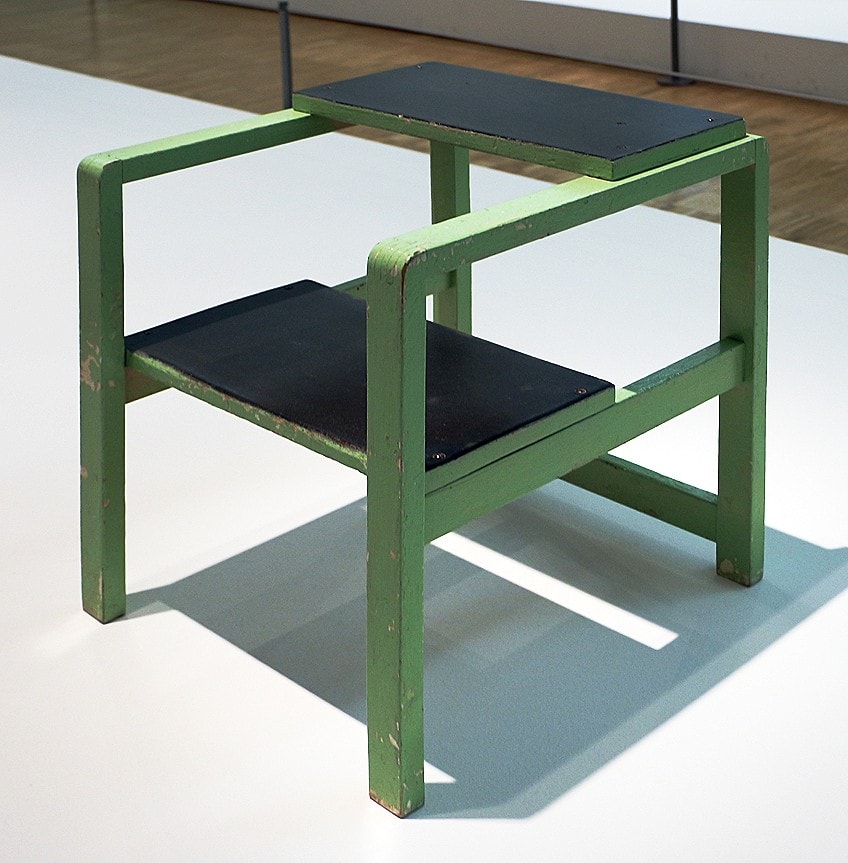 Chair (1925) past Erich Dieckmann;Sailko, Public domain, via Wikimedia Commons
Chair (1925) past Erich Dieckmann;Sailko, Public domain, via Wikimedia Commons
These seminars stressed functionalism, especially the use of basic geometric shapes that could exist easily replicated, which would become a theoretical centerpiece of modernist design and architecture in the coming decades. Courses specialized in constructing developments were at the hub of the cycle, educating students on the fundamentals of architecture, construction, and engineering, just with a focus on skills and craftsmanship that were thought to accept been lost in gimmicky building procedures.
One of the primary goals of the teaching method, which was used across all courses, was to reduce competitive inclinations and to encourage not just creative abilities but besides a feeling of collaboration and common goals.
The Kinesthesia of the Bauhaus
The phenomenally skilled professors that Gropius had drawn to Weimar were in charge of designing and delivering this curriculum. Gropius' earliest choices were avant-garde artists Johannes Itten and Lyonel Feininger, as well as sculptor Gerhard Marcks.
Itten was particularly crucial to the schoolhouse'due south determinative credo: with his Expressionism feel, he was behind much of the first focus on romantic medievalism that distinguished the Bauhaus, notably the preparatory course, which he developed.
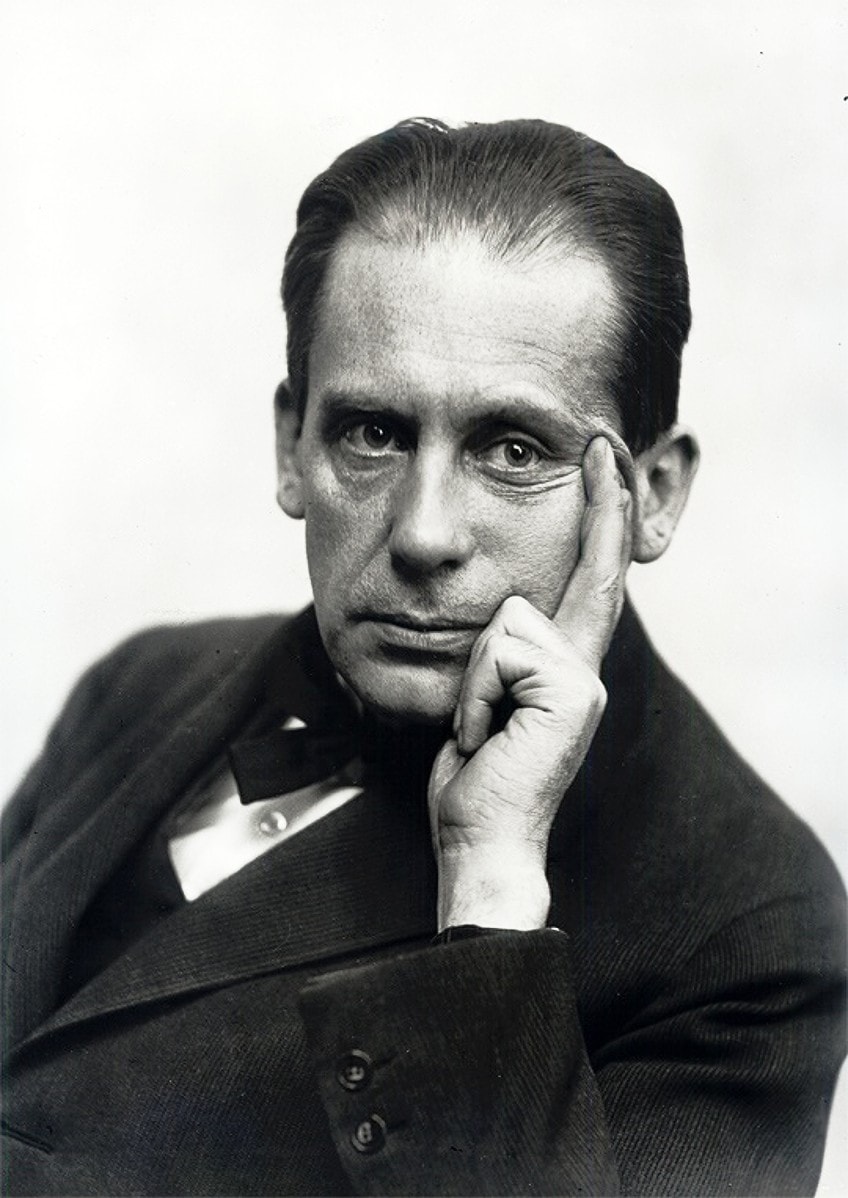 Photograph of Bauhaus founder Walter Gropius (1883 – 1969) taken c. 1919; Louis Held, Public domain, via Wikimedia Commons
Photograph of Bauhaus founder Walter Gropius (1883 – 1969) taken c. 1919; Louis Held, Public domain, via Wikimedia Commons
His Expressionist and mystical proclivities famously placed him at odds with Gropius' analytical, sociologically minded attitude, and the ii quickly clashed. Itten had gone by 1923, to be succeeded past László Moholy-Nagy, a more plumbing fixtures kindred personality to Gropius; Moholy-Nagy reshaped the curriculum that incorporated technology and the social role of fine art.
Yet, during the duration of its short existence, the Bauhaus absorbed a variety of stylistic influences.
Though names like Moholy-Nagy are today identified with the technical philosophy of Constructivism, other initial choices encompassed Expressionist and Expressionist-influenced artists similar Paul Klee and Wassily Kandinsky. They also featured artists working in many mediums, ranging from sculpture to dancing, such as Oskar Schlemmer and Georg Muche.
The Bauhaus Move in Dessau
The Bauhaus relocated to the High german manufacturing plant city of Dessau in 1925, kicking off its near prolific flow of development. Gropius synthetic a new structure for the schoolhouse that has go known non just as the Bauhaus' spiritual emblem, but also every bit a hallmark of contemporary, structuralist architecture.
It was also at this point that the school established a sectionalisation of architecture, which had been glaringly absent in its prior iteration. Gropius, on the other mitt, was worn down past his labor and mounting confrontations with the school's adversaries, specially conservative forces in High german culture, by 1928.
 The Bauhaus building in Dessau, Germany, was designed by Walter Gropius. Information technology was the longest-serving of the iii Bauhaus locations (1925 – 1932); Spyrosdrakopoulos, CC BY-SA 4.0, via Wikimedia Commons
The Bauhaus building in Dessau, Germany, was designed by Walter Gropius. Information technology was the longest-serving of the iii Bauhaus locations (1925 – 1932); Spyrosdrakopoulos, CC BY-SA 4.0, via Wikimedia Commons
He stepped aside, handing over the reins to Swiss builder Hannes Meyer. Meyer, who oversaw the architecture kinesthesia, was an enthusiastic communist who instilled his political behavior in student groups and educational initiatives. The institution increased in forcefulness, merely Meyer's Marxism came under fire, and he was fired equally director in 1930. After municipal elections in Dessau brought the Nazis to power in 1932, the school was once again shuttered and transferred, this occasion to Berlin, where it would remain for the rest of its life.
The Bauhaus was revived temporarily in Berlin under the guidance of architect Ludwig Mies van der Rohe, a well-known champion of functionalist design who, similar Gropius, was subsequently connected with the so-called International Aesthetic.
Mies van der Rohe, on the other hand, had to contend with significantly fewer facilities than his predecessors, too every bit a faculty devoid of many of its finest stars. He sought to remove politics from the school'southward plan, but this temporary rebranding attempt failed, and when the Nazis took national ability in 1933, the schoolhouse was shuttered indefinitely due to severe political harassment and intimidation.
After the Close of the Bauhaus Pattern Schoolhouse
The Bauhaus' impact would spread equally far as its previous teachers in the decades after its demise, many of them were forced to depart Europe as the suffocating impacts of fascism took control. Gropius moved to the U.s. in 1937 and lectured at Harvard University'due south Graduate School of Design, where he was regarded as crucial in spreading the International Architectural style to America.
Josef Albers had been named director of the painting school at the illustrious Black Mountain College in North Carolina four years earlier, where his pupils included Cy Twombly and Robert Rauschenberg. In 1933, afterwards fleeing Germany, László Moholy-Nagy founded the Establish of Blueprint in Chicago.
The Bauhaus's national heritage was also revitalized in the years following WWII, with the establishment of the Hochschule für Gestaltung in Ulm in 1953. This institution was the ideological heir to the Bauhaus motion in many aspects, with renowned Bauhaus pupil Max Bill selected as its first head.
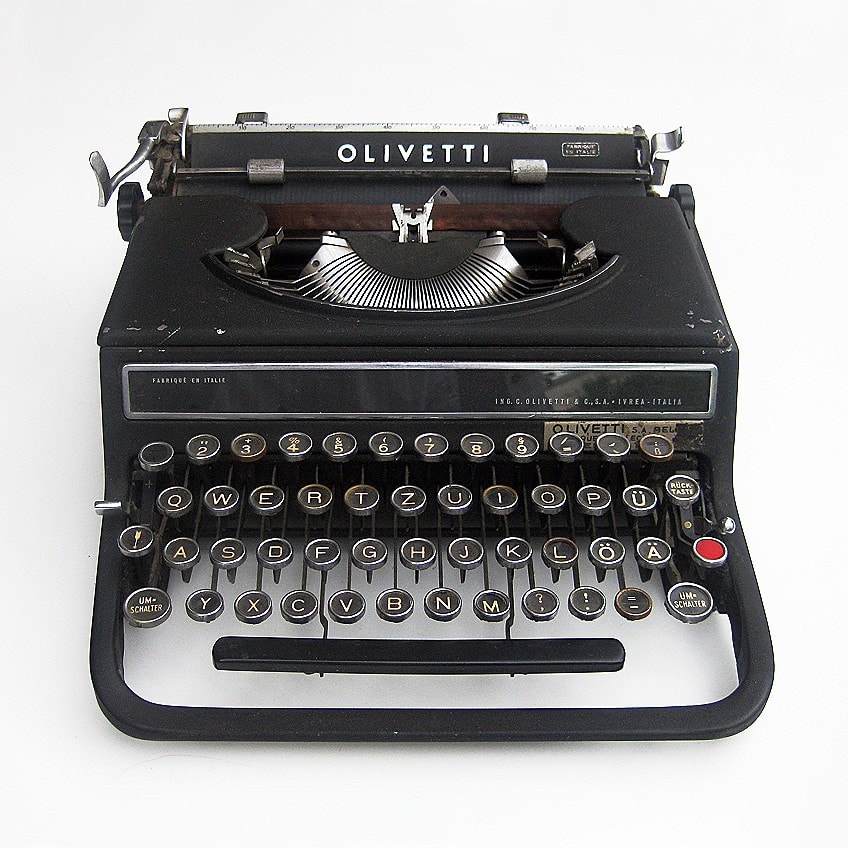 An Olivetti Studio 42 typewriter, designed by Bauhausler Xanti Schawinsky in 1936;ChristosV und/oder Christos Vittoratos, CC BY-SA iii.0, via Wikimedia Commons
An Olivetti Studio 42 typewriter, designed by Bauhausler Xanti Schawinsky in 1936;ChristosV und/oder Christos Vittoratos, CC BY-SA iii.0, via Wikimedia Commons
Moholy-Nagy, Bill, and Albers were peculiarly influential in modifying the Bauhaus ethos to a mod era: Moholy-Nagy and Albers reshaped information technology into one more than appropriate to a contemporary enquiry institution operation in a marketplace-oriented society, while Bill was instrumental in propagating geometric brainchild all through the globe in the shape of Concrete Art, a movement that succeeded Constructivism.
Key Ideas of Bauhaus Design
The Bauhaus was founded in the late 19th century, in response to concerns near the vapidity of contemporary production and the loss of social importance of art. The Bauhaus artists sought to reconcile fine art and utilitarian design past developing applied things with the essence of works of art.
Despite its rejection of many features of traditional fine-arts education, the Bauhaus was strongly interested in philosophical and conceptual perspectives on its topic.
Various components of creative and Bauhaus graphic design schooling were merged, and the Renaissance-era hierarchy of the arts was leveled: the utilitarian crafts – architectural and Bauhaus interior design, fabrics, and woodwork – were positioned on a level ground with fine arts like painting and sculpture. Given the Bauhaus's emphasis on both loftier art and utilitarian craft, it is not surprising that many of its nigh important and long-lasting successes were in domains other than sculpture and painting.
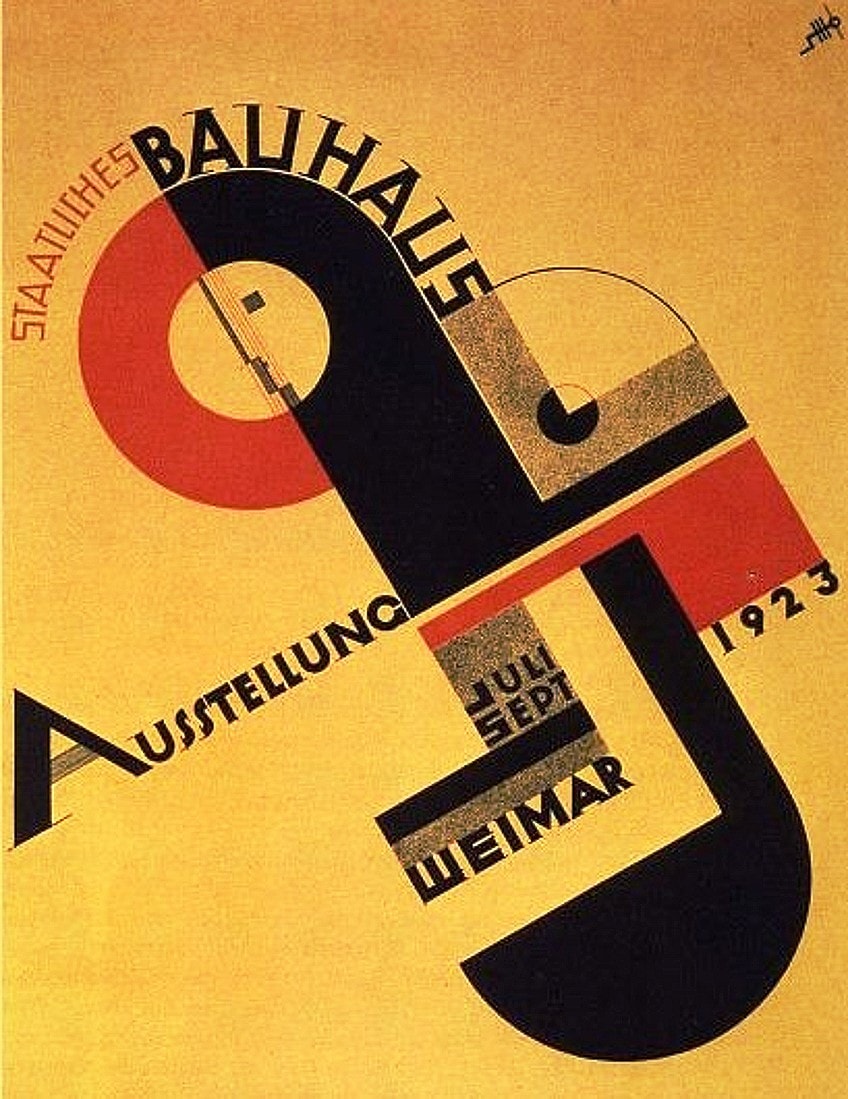 Affiche for the Bauhausaustellung (1923) designed by Joost Schmidt;Joost Schmidt , Public domain, via Wikimedia Commons
Affiche for the Bauhausaustellung (1923) designed by Joost Schmidt;Joost Schmidt , Public domain, via Wikimedia Commons
The decor and utensil blueprint features of Marcel Breuer, Marianne Brandt, and others prepared the path for the stylish simplicity of the 1950s and 1960s, while builders such as Ludwig Mies van der Rohe and Walter Gropius were regarded equally early pioneers of the equally fashionable International Manner that is so pregnant in architecture today.
The Bauhaus method of teaching, with its accent on experimentation and trouble-solving, has had a huge influence on current art education. It has resulted in a reimagining of the "fine arts" as "visual arts," equally well every bit a reworking of the artistic method as more comparable to a scientific scientific discipline than a humanistic topic like history or literature.
Important Bauhaus Artists and Artworks
The Bauhaus movement represents 1 of the nearly of import design philosophies of all time, marrying utilitarian design with artful enjoyment to create a new fine art course capable of bringing beauty to daily products and beyond. It was a watershed moment in graphic blueprint. Typography, layout, and the use of form and color were being reinterpreted in ways that would have a lasting influence on graphic design long into the twenty-first century.
The Bauhaus move and its contemporary manner had a huge impact on fine art and graphic blueprint, with the time'due south innovation and ideological upheavals influencing how we create to this very mean solar day.
Crimson Balloon (1922) by Paul Klee
| Date Completed | 1922 |
| Medium | Oil on Gauze |
| Dimensions | 32 cm 10 31 cm |
| Electric current Location | The Solomon R. Guggenheim Museum |
Paul Klee was a visionary whose work blended remarkable formal creativity with a foreign type of cardinal innocence. He was one of the most accomplished and intriguing painters affiliated with Bauhaus fine art and design. In this 1922 painting, fragile, transparent geometric figures – rectangles, squares, and domes – are highlighted in master colour gradations. A lone red circle hovers in the upper middle, exposing itself to exist the eponymous hot-air balloon upon closer study. This illustrated flourish shows Klee's playful, correlative employ of Bauhaus'southward famed geometric compositional structures.
The focus of the creative person's distinctive style changes tensely between the abstract and the representational, betwixt narrative connection and mystical symbolism. The luminous forms, suggestive of stained drinking glass, are arranged asymmetrically to produce an artful rhythm governed by horizontal, vertical, and diagonal lines that announced both organized and unplanned.
Klee, who was built-in in Switzerland in 1879, was involved with various modernist and Expressionist groups in Northern Europe from the 1900s and through the 1910s, including Der Blaue Reiter, before accepting a position at the Bauhaus in 1921, where he taught mural artwork, bookbinding, and other subjects.
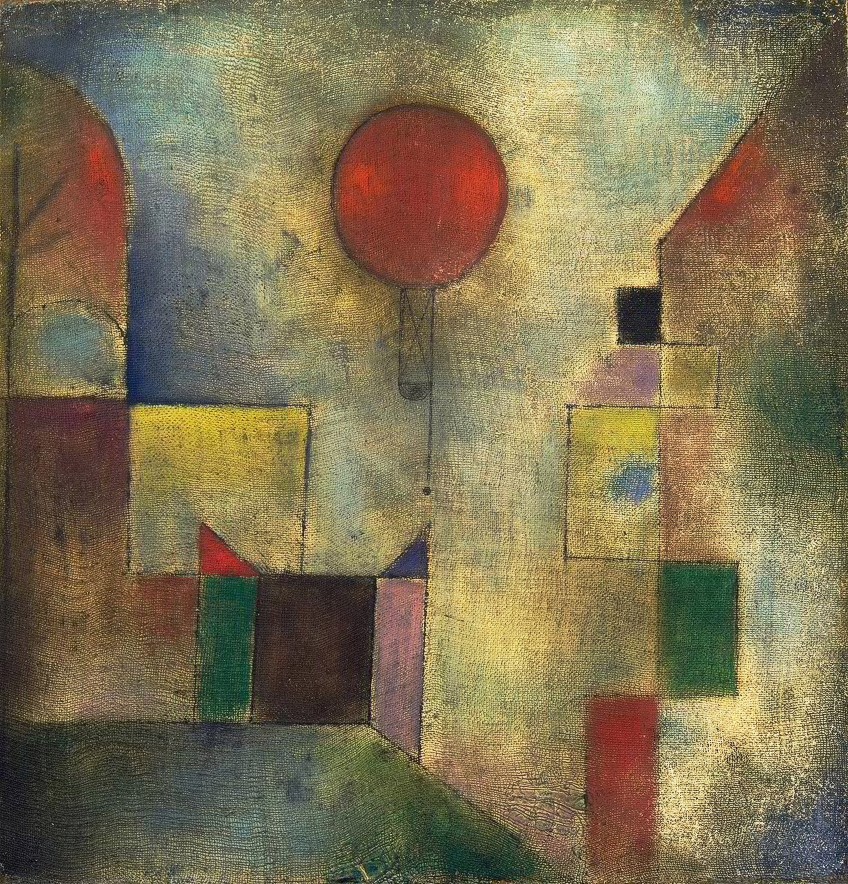 Red Airship(1922) past Paul Klee, located at the Solomon R. Guggenheim Museum in New York Metropolis; Paul Klee, Public domain, via Wikimedia Eatables
Red Airship(1922) past Paul Klee, located at the Solomon R. Guggenheim Museum in New York Metropolis; Paul Klee, Public domain, via Wikimedia Eatables
His art lessons were published in the Bauhausbücher series in his Pedagogical Sketchbooks (1925). This work, which began with the line "an constructive line on a walk, constantly moving, without objective," became enormously impactful, creating his renown as one of the excellent theorists of gimmicky art equally he tried to appraise every last possible combination of his restless lines. The line, For Klee, which grew from a single position, was an independent, impulsive agent whose movement shaped the formation of the airplane.
This analogy for the emergence of creative form became a central chemical element of Bauhaus blueprint theory, inspiring many of Klee's colleagues, notably Anni Albers and Klee'due south longtime friend Wassily Kandinsky. Klee's participation in the Bauhaus from 1921 until his retirement in 1931 debunks preconceptions of the schoolhouse as unduly focused on logic and formal, rigid procedures.
Klee's oeuvre influenced other painters in Europe and America, notably Adolph Gottlieb, Robert Motherwell, Kenneth Nolan, Norman Lewis, and William Baziotes, who saw information technology as simultaneously sophisticated and key, realistic and otherworldly. "Almost everyone, regardless of whether conscious or not, was studying Klee," Clement Greenburg wrote in 1957.
Yellow-Red-Blue (1925) past Wassily Kandinsky
| Date Completed | 1925 |
| Medium | Oil on Sail |
| Dimensions | 63 cm ten 92 cm |
| Current Location | Musée National d'Art Moderne, |
This intricate work is organized effectually 3 principal visual sections, which are emphasized by carmine, yellow, and blue forms. These, in plough, establish two main zones of visual focus, 1 on the right-hand side of the console, made by the interconnecting blueish circumvolve and scarlet cross, and one on the left, formed by the yellow rectangle impressed confronting a darker shade of ochre. Color and shade effects imply variation in perceptual weight and location in space, as the lightness of the xanthous contrasts with the deeper reddish tones, extending further into blue and majestic.
A meshwork of linear and curved lines collaborate throughout the canvass, as though reenacting the fight of free energy established betwixt the many key hues. Wassily Kandinsky was built-in in Moscow in 1866 and moved to Germany before the late 19th century, where he became a crucial figure in the advancement of Northern-European Expressionism over the next few years; his 1903 painting Der Blaue Reiter inspired the Expressionist art group of the same proper noun.
Kandinsky moved to Deutschland and started lecturing at the Bauhaus in 1922, after a half-dozen-yr stint in Soviet Russia sandwiching the revolution (1914 – 1920), by which point his artwork had progressed towards a refined form of abstraction. He exposed his pupils to the examination of fundamental colors and the structure of their human relationship as a tutor on the preparatory level.
In 1923, he created a survey in which respondents were asked to complete a triangle, square, or circumvolve with the most suitable primary color to discover an inherent qualitative link betwixt certain forms and colors. The consequent ruby square, yellow triangle, and blueish circle became a typical Bauhaus pattern, which Kandinsky investigated and manipulated in this well-known slice, changing it into a poetic representation of the link between artful and melodic expression.
The same concepts impacted his renowned essay "Point and Line to Plane" (1926), which was motivated by recent enquiry on Gestalt psychology, a prominent topic of debate at the Bauhaus at the time.
Kandinsky was intrigued by how detail line, color, and tone mixtures may have intrinsic psychological and spiritual consequences, which were and so linked to specific musical melodies. However, as art proficient Annagret Hoberg points out, the artwork's ramifications go beyond this, into more representational realms: "The two centers evoke anthropological overtones. While the arrangement of the circles and lines in the yellow field suggests a human contour, the interweaving of blueish and crimson forms with the black diagonal is evocative of the discipline of Saint George and the Dragon."
Maybe it is these more human connections that explicate Kandinsky's abstract works' legendary status in gimmicky fine art history: as Hoberg points out, Yellow-Red-Blue "expended a sway on subsequent modernism, which include, for instance, Barnett Newman'southward series Who's Afraid of Yellow, Red, and Blueish (1969)."
Lodge Chair (1925) by Marcel Breuer
| Date Completed | 1925 |
| Medium | Steel and Canvas Upholstery |
| Dimensions | 72 cm x 78 cm x 71 cm |
| Current Location | The Metropolitan Museum of Art, New York |
Marcel Breuer'due south famous chair is a novel twist on the classic upholstered 'club chair' of the 19th-century drawing room, a sleek fusion of curved, overlaying stainless steel tubes and tight rectangular cloth panels hovering like geometric objects in space. The chair was characterized past the artist equally "my most astringent piece is the least artistic, most rational, least 'cozy,' and most mechanistic."
Information technology was, nonetheless, his near significant work, demonstrating the breakthrough innovations in functional design that distinguished the Bauhaus past the mid-1920s. Information technology satisfied all of the criteria of the school's pattern ethos, beingness lightweight, readily movable, and mass-produced, with its components placed with a simplicity that made its structure and part conspicuously credible.
Breuer, who was born in Hungary in 1902, was one of the initial Bauhaus generation'southward youngest participants. He left his hometown of Pécs at the age of eighteen and enrolled as ane of the schoolhouse's offset pupils at Gropius' revolutionary new institution in 1920. He was chosen every bit a prodigy and given control of the woodwork shop, and afterward a brief stay in Paris, he returned to the Bauhaus equally a teacher in 1925.
Breuer, an avid biker, considered the cycle the epitome of contemporary blueprint and was captivated by his bicycle'southward curving handlebars, which were constructed of a new blazon of tubular steel produced by the Mannesmann manufacturing business organization. He recognized that the same substance, which could be twisted without cracking, might be employed in furniture design, and the "society chair" was built-in as a outcome of this epiphany. Breuer founded the business organization Standard Möbel in 1927 to mass-produce his article of furniture.
The chair'southward vernacular proper name celebrates the artist Wassily Kandinsky, who adored it when he first encountered it in Breuer's workshop. Breuer's chair was "the get-go-ever chair to use a bent-steel frame and it heralded the start of a revolutionary era in contemporary furniture with a form that retains a futuristic wait fifty-fifty now," co-ordinate to the art historian Seamus Payne.
Afterwards WWII, the Italian manufacturer Gavina began manufacturing the chair, confirming its long-term effect on design history and selling it every bit the "Wassily Chair." In 1968, the American manufacturer Knoll acquired Gavina and started producing the Model B3, which is still available today.
Universal Bayer (1925) by Herbert Bayer
| Engagement Completed | 1925 |
| Medium | Typeface |
| Dimensions | Northward/A |
| Electric current Location | N/A |
Herbert Bayer's Universal Bayer font, a classic of International Style typography, adopts a elementary style of the Bauhaus font. At the very same time, the style's simplicity shows Bayer'southward concern for improved readability, providing a considerable number of negative spaces between letters in dissimilarity to conventional High german typography'due south constricted calligraphic scripts.
Bayer intended written language to reflect the simplicity of oral communication, and chose only lower-example letters for this styling since there was no phonetic difference between the lower and upper case. Considering each character has the same dimension, they defined transferable places on the page.
As a result, the type was relatively unproblematic to use and could be converted to typewriter keyboards and typesetting equipment. These design elements wonderfully encapsulate the Bauhaus emphasis on utility and mass production. Bayer, similar Breuer, was a young representative of the Bauhaus' gilt generation, having been born in Austria in 1900. He began his career as an architect and, in the late 1910s, was a fellow member of the Darmstadt Artist'southward Colony, where he was influenced past the Jugendstil or Fine art Nouveau ideas of that group, likewise every bit its focus on the concept of the 'whole work of fine art.'
However, in 1920, Bayer became interested in Gropius' new venture and joined the school in 1921, learning under Kandinsky, Klee, and Moholy-Nagy. Afterwards returning to the Bauhaus every bit a teacher in 1925, he was named head of press and advertising during the Dessau era. After Gropius ordered him to produce a font that could exist used in all Bauhaus publications, he created the Universal Bayer typeface. At the time, most German printers yet used Fraktur, a hit Gothic typeface devised in the 16th century for Albrecht Dürer'south woodcut Triumphal Arch (1526).
Bayer conveyed the spirit of a new cultural phenomenon that rejected astern-looking nationalism in favor of international modernism, a movement championed past the Bauhaus and eventually wiped out by the Nazis, past removing the ornamentation from German language letters.
His pattern was also supposed to attach to a famous Bauhaus compositional principle, in which letters were organized in diagonal lines pushing upwards over the page, wrapped around objects, and highlighted in brilliant colors.
Although Bayer's font was never cast in metal, its effect was extensive and long-lasting. Along with existence at the frontline of advancements in International Style typography from the 1920s to the 1950s, affecting typefaces such as Architype Schwitters, it is also the motivation for Google's font. The font can besides be seen in several Bauhaus posters. Herbert Bayer's Bauhaus poster for the Kandinsky Exhibition in 1926 is an example.
Photogram (1926) by László Moholy-Nagy
| Engagement Completed | 1926 |
| Medium | Gelatin silver print |
| Dimensions | 23 cm x 18 cm |
| Current Location | The Metropolitan Museum of Art, New York |
The artist's mitt appears to ascend out of the darkness and float in space in this cameraless snapshot, or "photogram," behind a grid of flaming white lines that cross with his fingertips. The figures appear to emerge on the paper non merely as though gaining shape from the interaction of shadow and lite, just likewise as dematerialized echoes of tangible objects: they become traces of physical touch.
Various European designers, such as Christian Schad and Homo Ray, dabbled with the photogram – a phrase invented past Moholy-Nagy – under alternative titles during the 1910s and 1920s, only through Moholy-efforts, Nagy's these efforts of Abstract Photography became inextricably tied with the Bauhaus' groundbreaking ideology.
In 1895, László Moholy-Nagy was born in Hungary. He came to Germany in 1920, and Gropius requested him to accept over the institution's bones curriculum from Johannes Itten in 1923, with his artistic renown already established. Moholy-photograms became emblems of Bauhaus innovation, fifty-fifty though he worked in a diverseness of mediums. These works, which were created by putting things on photograph-sensitive newspaper subjected to ambience light, make light "the cloth of plastic expression," in the artist'southward terms.
Despite the fact that photography was not formally part of the Bauhaus's curriculum, Moholy-Nagy worked in a one-man photographic section, and his zealous enthusiasm led many of the school's teachers and students to experiment with photography.
Moholgy-Nagy, who was fascinated by light, connected to investigate the potential of the photogram throughout his career, nigh prominently at the Chicago School of Design, which he created in 1939 after relocating to the United States.
Here, "lite laboratory" classes were required, and Moholy-work Nagy's influenced many future North-American artists, including Arthur Siegel. Moholy-photograms Nagy's are testaments to the Bauhaus'due south pioneering technological and creative ethos, particularly its devotion to investigating the fundamental qualities and abilities of many artistic mediums. In essence, they are investigations of photosensitivity principles in their purest, almost unadulterated form, and and then encapsulate the "form-follows-function" mentality currently associated with the Bauhaus and the larger Constructivism movement.
With that, we conclude our investigation of Bauhaus Design. The Bauhaus Schoolhouse influenced many aspects of applied fine art, such as Bauhaus interior design and Bauhaus graphic design. Bauhaus artists and their piece of work not only changed the creative landscape in its time but for many years to follow.
Frequently Asked Questions
What Is Bauhaus?
The Bauhaus was without a doubt the near of import progressive art school of the 20th century, and it was responsible for the development of many well-known Bauhaus artists. The Bauhaus pattern school'due south perspective toward education and the relationship betwixt gild, fine art, and applied science had a tremendous impact in the United States and Europe, even after it disbanded nether Nazi pressure in 1933. The schoolhouse's strategy was based on its cut-edge and effective curriculum. The outer circumvolve was selected to represent the half-dozen-calendar month preparation schoolhouse founded by Johannes Itten that concentrated on the basic components of pattern, notably the varying features of different forms, colors, and materials, according to Gropius.
What Defines the Bauhaus Fashion?
Art Nouveau and its numerous foreign variants, such as the Vienna Secession and Jugendstil, too as the Arts and Crafts motion, influenced the Bauhaus style in the 19th and early 20th centuries. All of these organizations wanted to blur the lines betwixt practical and fine arts, likewise every bit integrate imagination and manufacturing. This history was reflected in the romantic medievalism of the Bauhaus movement's philosophy during its early on years when it posed as a craftsmen's union.
Source: https://artincontext.org/bauhaus-art/
0 Response to "These Bauhaus Art Students in 1927 Look Like Postpunk Bauhaus Fans"
Post a Comment